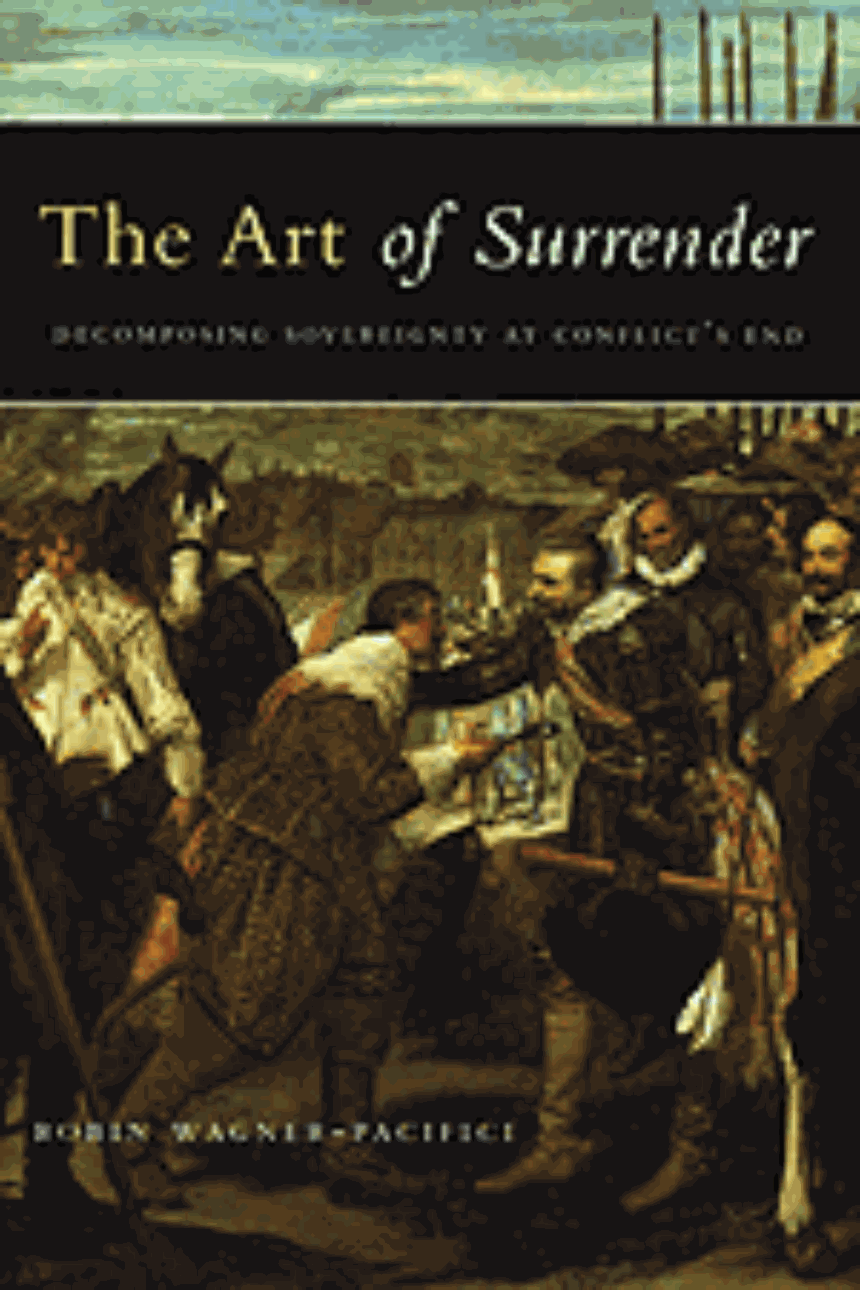The Art of Surrender
Decomposing Sovereignty at Conflict’s End
How do we know when a war ends? For many, the resolution of a conflict comes not with the last traces of smoke left on the battlefield, but with the formal ceremonies of surrender: possession and repossession, the signing of treaties, and the pomp and circumstance that mark them. Historically, most conflicts have ended with such rituals. But, as Robin Wagner-Pacifici reveals in The Art of Surrender, they should not be seen as merely a matter of giving up. They also offer ways of holding back and signal early fault lines that give rise to later undoings and conflicts.
The Art of Surrender explores these ritual concessions as acts of warfare, performances of submission, demonstrations of power, and representations of shifting, unstable worlds. Wagner-Pacifici analyzes three significant military surrenders in the history of warfare—the Thirty Years’ War of the seventeenth century, the American Civil War, and World War II—through the use of period documents and forms, maps, literature, witness accounts, photographs, and paintings that were left as proof of victory and defeat. In her analyses of such archival material and iconic works of art, she considers the limits of sovereignty at conflict’s end, showing how the ways we concede loss can be as important as the ways we claim victory.
The Art of Surrender explores these ritual concessions as acts of warfare, performances of submission, demonstrations of power, and representations of shifting, unstable worlds. Wagner-Pacifici analyzes three significant military surrenders in the history of warfare—the Thirty Years’ War of the seventeenth century, the American Civil War, and World War II—through the use of period documents and forms, maps, literature, witness accounts, photographs, and paintings that were left as proof of victory and defeat. In her analyses of such archival material and iconic works of art, she considers the limits of sovereignty at conflict’s end, showing how the ways we concede loss can be as important as the ways we claim victory.
224 pages | 9 color plates, 9 halftones | 6 x 9 | © 2005
Art: Art--General Studies
History: Military History
Political Science: Diplomacy, Foreign Policy, and International Relations
Sociology: General Sociology
Reviews
Table of Contents
Preface
Acknowledgments
1. The Problem of Surrender
The End
Archetypes in Action: A Word on Method
Cases of Surrender
The Archaism of Surrender
The Conditions of Surrender: Toward a Political Semiotic
Converging to Convert
The Etymology of Surrender
Etymological Coda
Surrenders as Actions in the Interstices
The Copies of Surrender
2. Witness to Surrender
Bearing Witness at Breda
What Is a Witness?
The Visual Order of the Witness
Where Is the Witness?
What Does the Witness Do?
Signatories to the Scene
Witness to a Disappearance
Looking at the Vanishing Point
Paper and Responsibility
3. The Exchanges of Surrender
The Dangers of Surrender
The Case of the Unconditional Surrender
The Nature of the Surrendering Exchange
The Objects of Exchange
Originary and Secondary Objects of Contention
A Note on the Work of Maps
Civil War Territory
The Fates of Warriors and Civilians
Transactional Objects of the Process of Surrender
Pledges, Oaths, Promises, and Pardons
Instruments and Weapons of War
Symbolic Objects of Authority and Solidarity
Tributes, Demonstrations, and Gestures
Sites of Exchange
Convergence and Divergence
4. Sovereignty and Its Afterlife
What Is Sovereignty?
Types of Sovereignty
Erotic Exchange and Vicarious Surrender
Actions of the Sovereign
Assumption and Divestment of Responsibility
The Itinerant Sovereign
How to Recognize the Sovereign
Mapping Sovereign Relations
Agency without Sovereignty
How to Represent the Sovereign
The Multiplicity of Singularity
Sovereignty at the Scene?
The Uncopied
5. The Deep Structure of Surrender
Borderline Scrutinies
Uneasy Appearances
The Political Semiotic at Conflict’s End
Demonstration and Deictics
Deictic Deferrals
Performatives and Transformations
Representations
Copies and Their Inversions
Underrepresentation and the Civil War
On the Threshold of Assumptions and Divestments
Notes
Bibliography
Index
Acknowledgments
1. The Problem of Surrender
The End
Archetypes in Action: A Word on Method
Cases of Surrender
The Archaism of Surrender
The Conditions of Surrender: Toward a Political Semiotic
Converging to Convert
The Etymology of Surrender
Etymological Coda
Surrenders as Actions in the Interstices
The Copies of Surrender
2. Witness to Surrender
Bearing Witness at Breda
What Is a Witness?
The Visual Order of the Witness
Where Is the Witness?
What Does the Witness Do?
Signatories to the Scene
Witness to a Disappearance
Looking at the Vanishing Point
Paper and Responsibility
3. The Exchanges of Surrender
The Dangers of Surrender
The Case of the Unconditional Surrender
The Nature of the Surrendering Exchange
The Objects of Exchange
Originary and Secondary Objects of Contention
A Note on the Work of Maps
Civil War Territory
The Fates of Warriors and Civilians
Transactional Objects of the Process of Surrender
Pledges, Oaths, Promises, and Pardons
Instruments and Weapons of War
Symbolic Objects of Authority and Solidarity
Tributes, Demonstrations, and Gestures
Sites of Exchange
Convergence and Divergence
4. Sovereignty and Its Afterlife
What Is Sovereignty?
Types of Sovereignty
Erotic Exchange and Vicarious Surrender
Actions of the Sovereign
Assumption and Divestment of Responsibility
The Itinerant Sovereign
How to Recognize the Sovereign
Mapping Sovereign Relations
Agency without Sovereignty
How to Represent the Sovereign
The Multiplicity of Singularity
Sovereignty at the Scene?
The Uncopied
5. The Deep Structure of Surrender
Borderline Scrutinies
Uneasy Appearances
The Political Semiotic at Conflict’s End
Demonstration and Deictics
Deictic Deferrals
Performatives and Transformations
Representations
Copies and Their Inversions
Underrepresentation and the Civil War
On the Threshold of Assumptions and Divestments
Notes
Bibliography
Index
